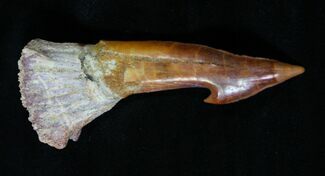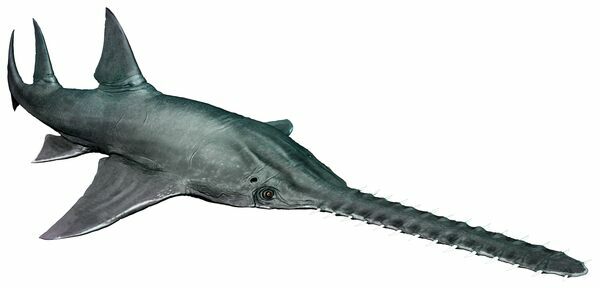ONCHOPRISTIS (GIANT SAWSKATE) FOSSILS FOR SALE
Fossil rostral barbs are frequently found in the Kem Kem Beds of Eastern Morocco where Onchopristis occupied the same habitat as the fearsome Spinosaurus. It almost certainly made up a primary food source of this semi-aquatic theropod dinosaur.
Onchopristis Giant Sawtooth Of The Kem Kem Formation
Onchopristis (meaning “Giant Saw”) is a giant sawskate (Not sawfish! They are two different groups of saw-nosed fishes, the modern sawfish group Pristidae and the extinct sawskate group the Sclerorhynchidae) known from two species, Onchopristis numidus and Onchopristis dunklei. The sawskates are known for having large saw-like organs called a rostrum, which projected like a nose from the front of their heads. These rostra were used in the detection and subduing of prey, with the help of special barbed teeth that lined their sides. The more well known of the two Onchopristis species, O. numidus, grew to a maximum of 28 feet (8.5m). O. numidus is known from the late cretaceous Kem Kem beds of North Africa, approximately 90-100 million years ago. The Kem Kem beds have been a site of many important Cretaceous African fossil finds for the past century, including Spinosaurus, the largest known theropod dinosaur, and a likely predator of Onchopristis.
Quick Facts:
Onchopristis Description
Onchopristis was part of an extinct family of “sawskates”, called the Sclerorhynchidae. The sawskates, which are more closely related to modern seaskates than they are to sawfish, were a group of cartilaginous carnivorous bottom-feeding fishes that lived in brackish and saltwater habitats nearly worldwide. These sawskates are primarily characterized by the large saw organ, or rostrum, which projected like a nose from the front of their heads. These rostra were adorned with large specialized teeth, called denticles. In the genus Onchopristis, as well as in several related sclerorhynchids, these denticles had backwards pointing barbs, making them harpoon-like in appearance and function.
Onchopristis was one of the largest of the sclerorhynchids, and one of the largest fish in its environment. Reaching up to 26-30 feet (8-9m), it lived as a benthic predator, using its rostrum to scan and prod the murky waters of the north African brackish delta it called home. By flushing out prey such as small vertebrates, crustaceans, and molluscs, Onchopristis would then have slashed at them with its rostrum, cutting them into pieces or harpooning them on its barbed denticles. Onchopristis’s teeth were small, indicating its mouth was likely small as well (similar to modern sawfish, which fill a similar niche) and can even grow to nearly the same size as Onchopristis. Because of its small mouth, it is unlikely that Onchopristis was hunting anything that couldn’t already fit in its mouth.
Like many sharks and rays, the sawskate Onchopristis fossilizes poorly due to its mostly cartilagenous skeleton. In spite of this, Onchopristis’ success and ubiquity in its era has left behind a wealth of fossils, mainly in the form of fragmented cranial remains and specialized teeth, called “rostral denticles”. The purpose of these denticles is hotly debated, but the prevailing line of thinking is that they were used in a similar manner to the convergently evolved sawfish of the modern day. Sawfish use their long saw organs like radar or a metal detector, probing the brackish waters in which they make their habitats, prodding at the riverbed or seafloor to dredge up all manner of soft and hard-bodied prey animals.
This brings some things into question, however. For one thing, sawfish today have single-pointed denticles on their saw organs, while Onchopristis and related species had backwards-pointing barbs on each of its denticles. The purpose of these barbs is not immediately evident. If the intent is to cut prey like modern sawfish, the barbs would have served to keep struggling prey from escaping easily, likely injuring animals that did manage to unhook themselves in the process.
On Rostra And Denticles
Prevailing thought indicates that because of the similarity of adaptation, Onchopristis likely lived and behaved in a similar manner to modern sawfish. Sawfish of today use their rostra to probe at the seabed and flush out small prey animals, which are then dispatched with lateral strikes from the denticle-lined edges of the rostra. However, Onchopristis’ denticles were slightly different, as they had barbed tips that made them function similar to harpoons instead of a cutting tool. This would have still served a similar purpose, injuring prey animals and rendering them much easier to eat with its mouth.
Dr Charles Underwood of the University of London, a paleontological researcher with a focus in sharks and their relatives, suggests that the barbs of Onchopristis’ denticles may have been a defensive adaptation, pointing to the lack of hard wear on fossils. In an interview with David Moscato of Earth Touch News Network in 2017, he states that the bones don’t show evidence of the wear typical of hard contact with substances like sand or bone, and suggests the rostra may have instead been swung at shoals of fish or rival males during intraspecific disputes.
Works Cited
 Reviews
Reviews



